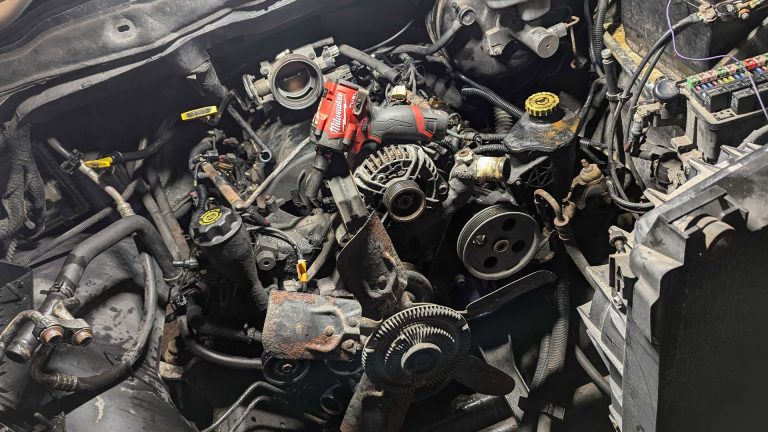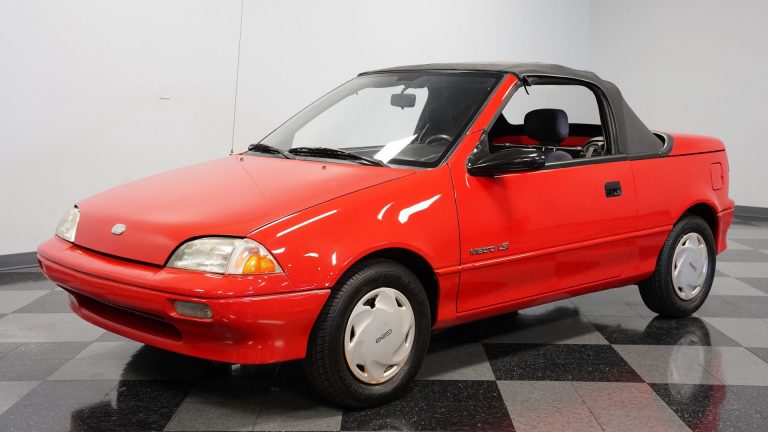We Tested Every Lexus GX Generation On- and Off-Road. Here’s How They Compare

In 2003, Lexus gave us the first generation GX 470 and set a standard for great luxury adventure vehicles with real reliability. In 2010, the second-gen GX 460 refined the formula a little. Now in 2024, after 14 years, the banner has been passed from the GX 460 to the new GX 550. I was able to get all three together for an on- and off-road comparison trip to see what each one is like in the context of its kin.
The goal of this trip was to get a feel for the new GX 550 and get a better understanding of how it relates to its predecessors. I originally thought I’d rank the 550, 470, and 460 like a good ol’-fashion comparison test—first, second, third—but that isn’t really fair or valuable. There are nearly 20 years of style and technology between these things. They were all born in different regulatory environments, and perhaps most importantly, they all represent very different price points. Instead, we’ll compare their characters. I’ll talk about details for each that I love and some things I don’t love and in the end we’ll come back to the big question: Is the new GX a worthy successor to what I think is the best SUV?
The Lexus GX is a bit of a contradiction. It’s a luxury vehicle from a brand associated with comfort and ease, but it’s based on a global Land Cruiser Prado which is known for playing and working in the dirt. The GX is never the strongest contender in any one category and it rarely wins comparison tests, yet it’s highly regarded by new and used buyers alike. New buyers value its reliability, resale value, and well-rounded package. Used buyers know it represents fantastic value for money as the utility and off-road wagon it has always been.
It would be cynical but fair to call it compromised. But the GX, like a good recipe, has ingredients that are well-balanced and carefully crafted to produce something greater than the sum of its parts. What the GX excels at is doing everything well enough to make a great all-rounder.


I gathered all three generations for a shootout in the Utah desert. The test involved around 400 miles of city, highway, and light trail use. I also camped out of the new GX 550 to see how it handled that role.
2008 GX 470: Still Fun
The first-gen GX was made from 2003 to 2008. Mine is a 2008 with 205,000 miles and is my wife’s daily driver. You can pick one up for between $10,000 and $20,000 these days in good condition.

Lexus had a problem on its hands when it decided to bring the J120 Land Cruiser Prado to the North American market, as the 2.8-liter four-cylinder turbo diesel it was designed for wasn’t going to cut it with luxury buyers. Thankfully, Toyota had the answer in the excellent 2UZ-FE 4.7-liter V8. Based on the legendary LS 400’s 1UZ-FE V8 but tuned for truck duty, it produces 263 horsepower and 323 hp in later models with VVT-i like my 2008. It’s a very smooth, reliable, and well-loved engine that will happily do many hundreds of thousands of miles.
On the road, the 470 feels lightest in the group and it is. At “only” 4,870 pounds, the 470 is 800 pounds lighter than the GX 550 and you can feel it. With an eager throttle and a linear power curve, the 470 feels like the faster of the two naturally aspirated GXs here. I ran two acceleration sets for all GXs, one at 5,555 feet on extremely compacted dirt with a full camp load and one set at 4,740 feet empty on asphalt. An average time of 10.7 seconds with a load and 9.5 seconds unladen good given the altitude. New and at-sea-level testers saw 8.1 seconds.

With its optional variable dampers set to the firmest setting, the 470 is surprisingly playful on the road and in the dirt. All GXs have near 50/50 weight distribution and full-time 4WD through a Torsen center differential with 40/60 rear bias which gives impeccable traction and balance. Its relatively low weight, perfectly weighted hydraulic steering, even weight balance, and linear power make the GX 470 a joy to drive hard. In the dirt, it feels small, nimble, and willing, with rotation easily modulated with the throttle. On-road, the excellent steering feedback through the hardwood and leather wheel, firm variable dampers, great engine note, and seamless full-time rear-biased 4WD traction deliver a car that drives a lot better than it looks like it will.
However, the 470 is easily the softest sprung here which takes a little sharpness from the experience. Though it’s the smoothest riding GX on washboard and bumpy roads, it takes the small bump compliance trophy. The downside is that the front coils and rear air springs find the bump stops abruptly and often. The 470 feels like it has the least travel here and is the one you have to be most careful with on trails that may hold sudden dips.
To test traction and geometry we found a steep, loose, and shale-covered hill with offset dips and a breakover obstacle at the top. On our tougher hill climb test, the 470’s first-gen ATRAC showed its age with less smooth power delivery, but it scrambled right up with little visible drama. Though it has the best approach and departure angles in this group (30 and 25 degrees, respectively), the limiting factor is still low hanging body or trim, not mechanical ability. The sidesteps and door skirts can be removed and trimmed relatively easily and the front and rear bumpers are the best stock and easiest to modify among this group. Like the others, this test was done in low range with the center differential locked.



For people and cargo, the GX 470’s biggest advantage is Toyota’s old-school side-flip third-row seats. Contemporary reviewers generally disparaged this funky arrangement when it debuted in the ‘90s and described it as anachronistic at best by the time it ended in the 200 Series Land Cruiser in 2023. But I think it’s a better solution than the replacement used in the other two models. The third row folds forward then up to the side in two parts when not needed. The seats are light and extremely easy to remove with a single spring-loaded button when you want more cargo volume. The tradeoff for this versatility is that the third row is the least commodious in this group for people.
One feature that does deserve derision is the side-swing rear gate with fixed glass, which swings the wrong way for left-hand drive markets and makes loading in a tight space or against a curb awkward. The main benefit of this door for the right-hand drive Land Cruiser Prado was to move the spare tire from underneath the cargo floor to the backdoor to make room for an auxiliary fuel tank. The North American GX got neither and thus lives with a compromised door without benefit.

With a large V8 and a small 23-gallon fuel tank, the GX 470’s biggest weakness is range. I find that I have to fill up at around 220 miles for city driving and far more frequently towing. EPA ratings are 14/18 city/highway, the lowest here, but in practice, it averaged 20.65 mpg, the best in the group. On the highway, the five-speed automatic does a decent job of keeping revs low and I can regularly average 20 mpg or more.
The 470 is the smallest and lightest, it has the smallest turning circle at 37.4 feet and it has the best objective and subjective visibility in the group. It also got the best average mpg and has the most cargo volume and versatility. While it gives up passenger room and speed compared to the other two, it’s a fantastic package even today. For our War Zone friends, I would compare the 470 to an F-16—visibility for days, crazy versatile, agile, awful range but ready, willing, and able for almost any mission.
| Highlights | Weak Spots |
|---|---|
| Great engine | The worst headlights known to man |
| Cargo versatility | Poor city and towing range |
| Great size | Timing belt service |
| Visibility | Eats brake pads like candy |
2017 GX 460: Incremental Upgrades
The second-gen GX was made from 2009 to 2023. Our test vehicle was a Sport trim belonging to my good friend Wade who passed 100,000 miles on this trip. As a result of having had such a long run, these range widely in price selling anywhere between $15,000 and $70,000 today.

The GX 460 is a quintessential 2010s Toyota—small steps, low risk. It’s everything the GX 470 was, just a little more. A hair longer, more powerful, more fuel efficient, and a little sharper. The 4.6-liter 1UR-FE V8, while a clean-sheet design, didn’t really move the needle. With 301 hp at 5,500 rpm and torque now 329 lb-ft at 3,500 rpm, the smaller engine eked out a little more power a little higher in the rev range. More weight, too. These are 470 pounds heavier than the GX 470 it replaced.
Despite the added heft, it is the faster of the two V8s. Laden average 0-60 time is 10.5 seconds with an unladen average of 9 seconds. Contemporary test results show 7.8 at sea level.
While the 470 and 460 both have electronic throttles, only the 460 feels like it. A slight disconnect between throttle commanded and delivered can make the 460 feel more sluggish compared to the 470, which is a common criticism of this generation. I hear this can be solved with a pedal calibration tune.
The GX 460 drives like a GX 470 but buttoned up a little tighter, grown up a little, and much more chill about it. The steering feel is dialed back, sound and general noise, vibration, and harshness are better insulated, and even little things like the second-row seat mechanism feel just a bit more “premium.” Where the 470’s second-row folds and tumbles forward, the second row in the 460 is on ball-bearing sliders which allow for one-handed sliding for third-row ingress and egress as well as fore and aft legroom adjustment tradeoffs for the third-row passengers.

Where growing up gives, it also takes, and the 460’s third row is a step backward in my opinion. In place of a third row that is easily removable for more space, you get a more permanently installed fold-forward design that feels, let’s say “packaging challenged.” When you open the side-swing rear door (which still opens on the wrong side but now has opening glass) you are greeted with a tall artificial ledge above the natural load floor as the third-row module replaces the natural floor. It looks like an afterthought, eats up three cubic feet of cargo volume, and doesn’t remove without tools. The combination of a sliding second row and more hip-to-floor space makes the third row more usable for actual humans though, and for families that need it on the regular, it’s a step up from the GX 470.
The GX 460, like all GXs, feels comfortable and at home in the dirt, but is also at odds with its own bodywork. With the worst approach and departure angles (21 for both) the GX 460 is the least prepared for off-road travel in stock form. And the spindle front grill makes a mockery of its clean design heritage and its off-road-focused mission.
Much of what’s good underneath remains, however, and the all-coil suspension feels like it has more travel and better bottom-out characteristics. On the big hill challenge, the 460 managed quite well despite its street-oriented tires and bodywork. Both it and the GX 470 scraped on the breakover part of the hill, but it merely touched on skid plates and carried on without complaint.



In many measurable ways, the GX 460 is superior to the model it supplanted. But it loses a little of the fun and flexibility in the process. It has better EPA mpg numbers of 15/20, but in my testing, it was mid-pack in actual mileage with a 19.2-mpg average. It’s faster than the 470 but feels a little slower. It has the worst visibility but is still well above average. It’s actually an outstanding vehicle, in a very mundane way, which was peak 2010s Toyota, I suppose. Growing up is hard.
| Highlights | Weak Spots |
|---|---|
| Faster, smoother, stronger | Poor cargo versatility |
| Sliding, folding second row | Poor city range |
| Rear hatch opening glass | That face |
2024 GX 550: Now and Future King
The new-for-2024 Lexus GX represents a major aesthetic departure from the old truck. It starts at $64,250, but this loaded Luxury+ trim we were loaned from Lexus’ press fleet lists for $84,395. The off-road focused Overtrail trim starts at $69,250.

This is the longest, widest, tallest, heaviest, and most powerful GX. That shouldn’t surprise anyone these days when a modern Corolla is the size of an old Camry and a fourth-gen Tacoma is the size of Kansas. This GX 550 has moved up a size and is now dead even with my 1997 80 Series Land Cruiser in most dimensions and is actually longer than the 80. This GX gen is much closer tied to the current “full” Land Cruiser, the 300 Series, and LX 600 as well, sharing a nearly identical frame and drivetrain.
One area where this and the larger LX differ is that this looks good. Sorry LX, I want to love you, but you are a dog compared to this handsome GX. Nearly everyone who saw it loved the new look, even if it does look like a stormtrooper in this trim and color.
Joining the dark side gets you a 3.4-liter twin-turbo V6, the V35A-FTS, which claims 349 hp and 479 lb-ft of torque versus 409 hp and 479 lb-ft in the LX. According to the vehicle’s chief engineer, the power delta comes from smaller, faster-spooling turbos on the GX. In contrast with its hefty 5,710-pound curb weight, 349 hp sounds a little light, but it’s enough and the area under the curve is meaty. 0-60 laden took an average of 9.19 seconds, and empty it averaged 7.33. It feels significantly quicker.



To address the elephant in the room, yes the V35A-FTS is the engine in the LX and Tundra which is being recalled for a fault in the manufacturing process that can lead to catastrophic engine failure. It should be noted that the recall currently doesn’t affect this model, but it is still a potential longevity red flag. By way of speculation, the GX 550 launch was initially delayed several months because of a production-related issue. I hear and suspect it was related to the engine. It is reasonable to assume that Lexus has solved that problem for all production GX 550 going forward.
EPA mileage is up marginally again to 15/21 but the GX 550 has the smallest fuel tank at 21.2 gallons. Does this new engine achieve big enough mileage gains to allay the GX’s chronic range issue? Nope. I averaged 18.1 mpg for the trip. It should be noted that boost is addicting and I definitely used it, as evidenced by my 14.7 mpg during the off-road portion, by far the lowest of the group. On other highway drives, I averaged around 20-21 mpg. Not really an improvement. I think, driven reasonably, it will be no worse than other GX except in towing.
I had hoped to test this, but I couldn’t get the integrated brake controller to play nice with my trailer. TFL’s Roman Mica had a similar problem with the Land Cruiser’s built-in brake controller in a recent tow test. I’d like to chalk that up to this still being a prototype vehicle. Tow rating is up to 7,000 pounds on this trim and up to 9,096 pounds on some trims and honestly, that’s a big plus for people like me that use the GX as a tow rig. The GX 470 just barely handles my 6,300-pound boat, but a rating and power buffer would be great.

Unique to the 3.4 engine is the Aisin 10-speed transmission. It works well, but this engine’s power delivery is such that you could probably get away with a three-speed. One feature I like is the ability to go up to seventh gear in low range in manual mode. This allows for a very high speed spread while in low range which means you don’t have to shift from high to low range as often. Shifting to low range is still done electronically, but the motors are stronger and faster. In a race from high range to low range, the 470, with its manual lever and a skilled hand would win, followed closely by the 550, and finally the lazy 460. It’s a small detail that matters to people like me.
While we are on the trail, so to speak, let’s talk about suspension. This was by far the best-balanced trail machine in terms of suspension performance. Small bump compliance is about on par with the 460, and just behind the 470, but medium bumps are swallowed up in a way the other two can only dream about. Engineers tell me that wheel travel has been increased on this chassis and you can tell. When you do max out the springs, the stops are soft and progressive. Even with the painted-on tires on this Luxury+ trim, I could move fast and confidently.
Surprisingly, this three-ton brick does an above-average rally car impression when asked. The cornering is impressively flat, the characteristic balance is there and the traction is magic. In Sport S+ mode the engine is more responsive, the adaptive dampers are firmer, and a fake engine note is pumped in to soothe your ego. The result is that it is far too easy to forget the size and weight of this battle wagon and build up a little too much speed. Throttle-on oversteer in the dirt is now finally on the menu.

The only real unwilling player is the steering; that is as light and accurate as it is dead. Zero feedback. Where the 470 wheel felt alive and talkative, the 550 wheel remained defiantly ignorant of whatever it was those degenerate front wheels were up to.
On our hill challenge, the long wheelbase 550 was the only one of the three that made it over the breakover portion without touching and it climbed the loose approach with no visual slip, though traction control did activate silently. Compared to previous generations of ATRAC which are noisy and intrusive, this is a huge improvement. Both traction control as well as stability control interventions were silent, fast-acting, and subtle without harsh intervention. One miss here is that not all trims of the GX come standard with a skid plate package. They all have fuel tank and transfer case skids, but this trim was missing a sump and transmission skid plate. This no doubt increased the ground clearance slightly, but I’d rather have the protection.
Inside, where the massaging front seats addressed my sore spots, the rear seats created new ones. The second-row seats are back to fold and tumble and the third-row is still the flip-forward design. They still look like an afterthought and they still eat up cargo volume and are worse than the side-fold design.
At least families will fit better than they used to, with rear row legroom growing 26% compared to the 470. Just don’t expect to take much stuff with you. Cargo volume is down to 40.2 and 10.3 cubic feet behind the second and third rows, respectively. Two-row models get a slightly better 45.6 cubic feet behind the second row. These numbers are down nearly 20% over the GX 470 despite being roughly 10% larger on the outside, another modern car “feature.”



With the biggest exterior dimensions and the longest wheelbase the GX 550 should be the obvious choice for moonlighting as a rustic motel. But unfortunately, I would say it’s the worst of the three for in-car sleeping. The space is there, but the seating is complicated. The GX 470’s length and fold and tumble second row require you to remove both second and third rows to lie flat, which you can do easily, leaving you a nearly flat volume. You can’t remove the GX 460’s second or third row easily, even with tools, but the flat-folding second row and third rows leave a relatively level cargo area. The GX 550’s lumpy fold and tumble second and third rows don’t make a flat load area in any combination with the second row being taller than the third in a stowed configuration giving both a sloping load floor and a large step between rows. With the right pad and prep work, it’s completely doable, but it’s the least accommodating.
Note: 12-volt and 110-volt power options are lacking for the overlander back here with no 12-volt outlets except the one in the front and a 110-volt outlet that wouldn’t charge my EcoFlow power station at all and requires you to turn on the inverter with each restart, unique among all three vehicles here.
You do get to enjoy power-operated views for the first time in a GX thanks to a switch from a side-opening gate to a top-opening hatch. This hatch is power-operated on this trim and also includes an opening glass section.

It needs a little work to be a great touring machine, but most modern vehicles do. It’s bigger but not unwieldy and it finally looks the part, though there is some concern about the upright windshield and cracks punctuated by a crack that was present when it was delivered from the last reviewer. Issues aside, I think the GX 550’s power, chassis architecture, and size put it on the top of the heap in this group. It has more passenger room, it can tow more, and it is more capable and comfortable off-road all while retaining its nimbleness and sightlines.
Most GXs live two lives. The first as white goods; sensible transportation for people who value reliability, durability, and resale more than economy or driving thrills. Most GX 550s will be non-Overtrail trims and probably painted in this or a similar sparkly white that seems to be the official color of the GX. They will live sensible suburban lives and service their first owners well for four to 10 years.
Waiting for their second life are people like me, looking for a great all-around vehicle with a little life experience but many trouble-free miles remaining. These are the people who are most likely to unlock the Land Cruiser inside and experience the GX as it was always meant to be.
If the GX 470 is an F-16, the GX 550 is an F-15. Powerful, smart, heavy, expensive, and ready to put in a day’s work. Like both the F-16 and F-15, chances are this GX 550 will still be serviceable for many many years to come.
| Highlights | Weak Spots |
|---|---|
| Easily the best off-road platform | Limited cargo and utility features, center console storage |
| Strong, confident, comfortable on the road | Brake controller didn’t work |
| The headlights are as good as the 470’s are bad. | Throttle response that can be hard to predict |
So who won? You win. If you can afford this level of SUV, whether you pick the scrappy little GX 470, the sensible GX 460, or the feature-laden GX 550, you still get the same basic recipe that hits just right. Which one would you take?

| Lexus GX Specs | 2008 GX 470 | 2017 GX 460 | 2024 GX 550 Luxury+ |
|---|---|---|---|
| Price | ~$10,000 to $20,000 | ~$15,000 to $70,000 | $82,600 |
| Powertrain | 4.7-liter V8 | 5-speed automatic | four-wheel drive | 4.6-liter V8 | 6-speed automatic | four-wheel drive | 3.4-liter twin-turbo V6 | 10-speed automatic | four-wheel drive |
| Horsepower | 263 @ 5,400 rpm | 301 @ 5,500 rpm | 349 @ 4,800-5,200 rpm |
| Torque | 323 lb-ft @ 3,400 rpm | 329 lb-ft @ 3,500 rpm | 479 lb-ft @ 2,000-3,600 rpm |
| Seating Capacity | 5 or 8 | 7 | 6 or 7 |
| Max Cargo Volume | 77.5 cubic feet | 64.7 cubic feet | 76.9 cubic feet |
| Curb Weight | 4,871 pounds | 5,130 pounds | 5,710 pounds |
| Max Towing | 6,500 pounds | 6,500 pounds | 7,601-7,800 pounds |
| Ground Clearance | 8.3 inches | 8.1 inches | 8.66 inches |
| Off-Road Angles | 31° approach | 25° departure | 21° approach | 21° breakover | 23° departure | 26° approach | 23° breakover | 21° departure |
| 0-60 mph | 8.1 seconds | 7.8 seconds | 6.5 seconds |
| Top Speed | 112.5 mph | 110 mph | 109 mph |
| EPA Fuel Economy | 14 mpg city | 18 highway | 15 combined | 15 mpg city | 18 highway | 16 combined | 15 mpg city | 21 highway | 17 combined |
Got tips? Send ’em to tips@thedrive.com
Source: www.thedrive.com






